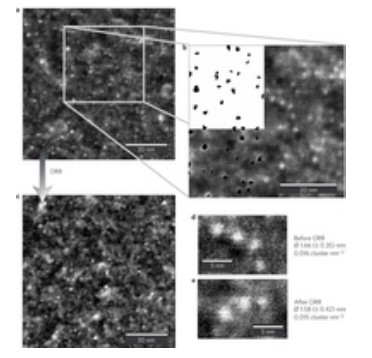Jul
24
A New Fuel Cell With 80% Less Platinum
July 24, 2013 | Leave a Comment
Matthias Arenz has built and tested a number of catalysts and is showing he can generate the same amount of electricity in a fuel cell with just a fifth of the platinum. If the technology can be commercialized it would be a huge financial advantage.

Platinum Nanoclusters on Glassy Carbon Electrodes SEM Micrographs. Image Credit: University of Copenhagen. Click image for the largest view.
Arenz, an associate professor at the Department of Chemistry, University of Copenhagen in collaboration with researchers from the Technical University München and the Max Planck Institute for Iron Research in Düsseldorf is confident that his discovery can show the way for economically viable fuel cell production.
Arenz knows and expects not to do quite that well in an everyday situation, but a marked reduction in platinum need is certainly realistic. The group’s discovery has been published in the journal Nature Materials.
Because fuel cells use the fuel much more efficiently fuel cells ought to replace internal combustion engines in our cars. They are better for the climate and for the environment and because they emit no smoke, no smog, no particulates and no CO2.
But unfortunately the fuel cells have a technical limitation. They only work if they contain the metal platinum which is less common and more costly than gold. This has been a considerable obstacle to the development of energy efficient power generation with fuel cells. Other ideas have come out, yet there is no fuel cell market taking off with new technology.
The basic problem is the precious metal platinum is one of the rarest elements on earth. Most of it is to be found in South Africa, where 80 percent of world production is mined while Russia extracts another ten percent. That makes the metal strategically important in every technology-producing nation.
For scale, note that 2012 world platinum production was 179 metric tons. By comparison gold production was 2,700 tons, 15 times more. And while the cost of platinum in 2010 has been running about $1,600 dollars per Troy Ounce gold is trading at about $1,300 dollars for a Troy Ounce.
Fuel cells produce electricity from hydrogen and oxygen in a what’s called a catalytic reaction that is kept going by the platinum. The greatest effect is achieved by flowing the gasses over a sheet or film of platinum that requires large amounts of the costly element. The best commercial modern fuel cells are made with particles, little granules, of platinum.
The research in Arenz’ group showed that these granules could be placed for more efficiency. When tested in the laboratory, catalysts bought on the market today will produce around one Ampere for every milligram of platinum. The Arenz group developed a fuel cell catalyst that got a whopping eight Amperes per milligram of platinum.
The initial thinking was that they got a bigger power yield because they had used smaller granules of platinum. But careful measurement revealed something much more surprising.
There is a view that the effect may have been found by chance. The group had produced a number of catalysts with varying sizes of platinum particles. By chance the particles were very tightly packed on a few of the sample catalysts and as it turned out, the packing of the particles was much more significant than the size.
The researchers have dubbed the effect “Particle Proximity Effect.” The key factor leading to the platinum savings might never have been discovered without curiosity and doing the careful measurement task.
Next will be developing a chemical method to produce tightly packed catalysts on an industrial scale. Arenz has a few ideas for that as well, so he and his group have started applying for grants.
We’ve seen several platinum replacement ideas over the years. One day one will break out into the market place making lots of fueled tasks fuel cell powered. If personal hydrogen production comes of age and fuel cells get technically proficient and low cost, the future would look very different, indeed.

